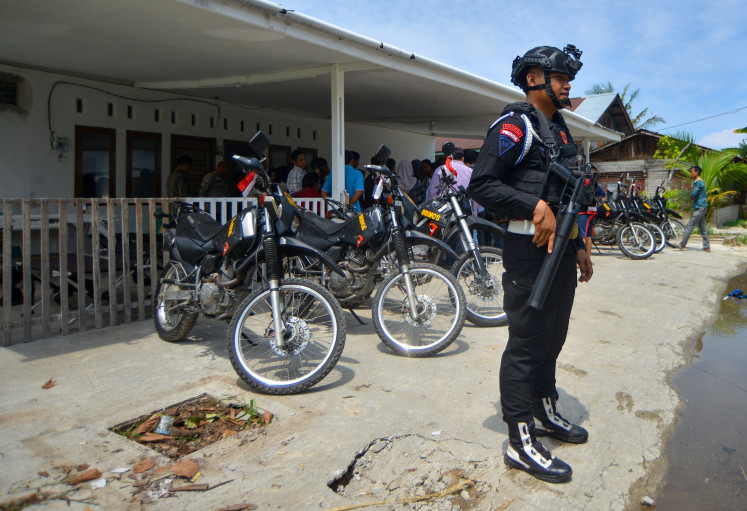Popular Reads
Top Results
Can't find what you're looking for?
View all search resultsPopular Reads
Top Results
Can't find what you're looking for?
View all search resultsLake Matano charms amid mining
Deep: Lake Matano in Sulawesi is the deepest lake in Southeast Asia
Change text size
Gift Premium Articles
to Anyone
Deep: Lake Matano in Sulawesi is the deepest lake in Southeast Asia. The area is also home to a nickel mine. (JP/Ruslan Sangadji)
Sorowako, a small town in East Luwu regency, South Sulawesi, is peaceful and clean.
On either side of its orderly roads are parks with flowers and pristine or rehabilitated woods, offering visitors a landscape of lush greenery to feast their eyes on.
Although Sorowako is not very well known, it is familiar to mining circles at home and overseas. Bordering Central and Southeast Sulawesi, the town is the domicile of PT Vale Indonesia Tbk, the world’s second largest nickel producing company.
Officially named Vale Indonesia in 2011, the mining company belongs to the Vale corporate network based in Brazil, with branches scattered over 38 countries.
Those who imagine the town as an isolated place with mining and not much else, a denuded forest without any entertainment, will change their minds when they observe the place’s beauty.
“It’s just like being abroad,” said Rolex Malaha, an editor at Jakarta’s Antara news agency, on his arrival in Sorowako.
A visit to Sorowako is not complete without a trip to the town’s captivating Lake Matano, the deepest lake in Southeast Asia and the eighth deepest in the world. The lake is surrounded by the Verbeek Mountains, the source of nickel and the base for Vale Indonesia’s operations.
Ashore: Lake Matano is not only a place for recreation but is used by locals to move between South Sulawesi and Central Sulawesi. The crossing costs Rp 20,000 (US$2.10). (JP/Ruslan Sangadji)
Lake Matano is certainly not as famous as Lake Toba in North Sumatra, but people who have visited the Middle East say Matano is comparable to the Dead Sea in Jordan. With a total area of 16,408 hectares, the lake is almost 600 meters deep with a water clarity of 20 meters.
Iskandar Siregar, a spokesman for PT Vale Indonesia, told The Jakarta Post that limnologists from the Indonesian Institute of Sciences had noted some unique features of Lake Matano not found in the other lakes in the country. The location below sea level is a rare phenomenon only rivaled by the Dead Sea. This condition causes Matano’s water to have a lower temperature on the surface and get warmer by 1 degree Celsius every 100 meters as one moves deeper.
According to Iskandar, the lake has an underwater cave, which is a major destination of researchers interested in the diversity of fish species. About 30 minutes’ sail from the cave there are four islets called the Cat Islands by locals due to their cat-like shape.
Divers can rent diving equipment at the local Yacht Club, which also offers instruction for beginners. Despite the absence of coral reefs, divers can still enjoy endemic lake biota like bungka crabs with their unique, batik patterns (Paratelphusa), freshwater snails (Brotia) and butini fish (Glossogobius matanensis).
“It’s safe here because no crocodiles live in this lake,” he added.
After a Matano tour, visitors can also enjoy the sounds of various songbirds around the lake. Photographs taken by Weldi Purwanto, an employee of PT Vale Indonesia, demonstrate the existence of 123 bird species living in the forest zone of Lake Matano.
Dewi M. Prawiradilaga, a zoologist from the Indonesian Institute of Sciences (LIPI), said 23 species of the 123 were endemic birds, including Sulawesi honey buzzards (Pernis Celebensis), serpent eagles (Spilornis Rufipectus), Sulawesi eagles (Spizaetus Lanceolatus) and kacamata or black-crowned White-eyes (Zosterops atrifrons).
Alight: Kacamata or black-crowned White-eyes (Zosterops atrifrons) are common in the Lake Matano area. One researcher sees subtle differences in Matano’s kacamata, perhaps indicating they are a unique species. (kutilang.or.id)
“We’re still researching them because the kacamata birds found in the Lake Matano area resemble those discovered in other regions
in Sulawesi,” said Dewi to the Post in Sorowako. According to her observations, Matano’s kacamata birds are slightly different so that they may be a special species of the lake.
The birds live on trees with shrubbery around them. They are easy to find and fond of playing in pools of water during hot days while uttering loud and melodious sounds. They feed mainly on insects and worms.
Lake Matano, according to the LIPI senior researcher, is in the Wallace line zone with its important biodiversity, particularly fauna. Sulawesi, which is surrounded by sea, has been conducive to the evolution of endemic bird species to a high degree.
“Sulawesi has the highest record of endemic birds in Indonesia, totaling 117 species or 31.4 percent of the country’s 372 endemic bird species,” she said.
The lake has economic value to the local population. Many road users cross the lake from Sorowako to Nuha district to save time to reach Central Sulawesi through Morowali.
Further, PT Vale Indonesia utilizes the lake’s water as an energy source of three 300-megawatt power generators in East Luwu.
Sorowako can be reached by air from Jakarta via Sultan Hasanuddin International Airport in Makassar, with six flights a week that take 45 minutes. With a fare of Rp 1,250,000 (US$130) per person, travelers go by a 45-seat Dash 7 aircraft owned by PT Vale Indonesia. No airlines yet ply this route.
The journey is 10 hours by bus from Makassar, but the vehicle is furnished with reclining seats complete with pillows and blankets.
In Sorowako, a number of hotels have rooms at rates ranging from Rp 150,000 to Rp 1 million a night. They generally boast magnificent sunrise and sunset views that can be enjoyed from the rooms.












